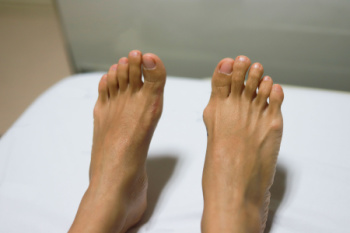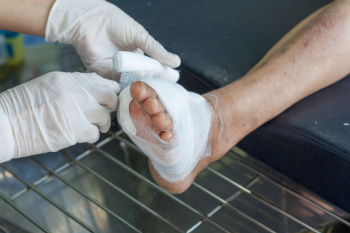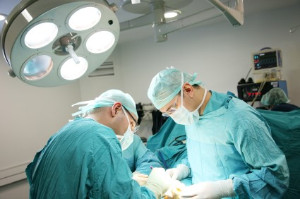Items filtered by date: February 2024
Non-Surgical Treatments for Bunions

Non-surgical treatments for bunions focus on relieving pain and discomfort, as well as slowing down the progression of the condition. Treatments include wearing comfortable shoes with a wide toe box to reduce pressure on the bunion, using padded inserts or orthotic devices to provide support and cushioning, and resting the foot to reduce swelling and inflammation. Toe spacers or splints may be used to help realign the toes gradually. Stretching and strengthening exercises for the foot and toe muscles can also improve flexibility and stability. While these treatments may not correct the bunion entirely, they can alleviate symptoms and improve quality of life for individuals with bunions who wish to avoid surgery. If you have a bunion that is causing discomfort, it is suggested that you visit a podiatrist regularly to track its progression, and adjust treatment as needed.
If you are suffering from bunion pain, contact Patrick Bruton, DPM of Big Country foot and Ankle. Our doctor can provide the care you need to keep you pain-free and on your feet.
What Is a Bunion?
Bunions are painful bony bumps that usually develop on the inside of the foot at the joint of the big toe. As the deformity increases over time, it may become painful to walk and wear shoes. Women are more likely to exacerbate existing bunions since they often wear tight, narrow shoes that shift their toes together. Bunion pain can be relieved by wearing wider shoes with enough room for the toes.
Causes
- Genetics – some people inherit feet that are more prone to bunion development
- Inflammatory Conditions - rheumatoid arthritis and polio may cause bunion development
Symptoms
- Redness and inflammation
- Pain and tenderness
- Callus or corns on the bump
- Restricted motion in the big toe
In order to diagnose your bunion, your podiatrist may ask about your medical history, symptoms, and general health. Your doctor might also order an x-ray to take a closer look at your feet. Nonsurgical treatment options include orthotics, padding, icing, changes in footwear, and medication. If nonsurgical treatments don’t alleviate your bunion pain, surgery may be necessary.
If you have any questions, please feel free to contact our offices located in Abilene, and Brownwood, TX . We offer the newest diagnostic and treatment technologies for all your foot care needs.
Understanding the Role of Sesamoid Bones and Sesamoiditis in the Feet

Sesamoid bones are small, specialized bones embedded within tendons, and play a critical role in the function of the feet. Positioned beneath the first metatarsal head, sesamoid bones provide leverage and support to the big toe, facilitating smooth movement and weight distribution during activities such as walking, running, and jumping. Despite their importance, sesamoid bones are prone to injury and inflammation, a condition known as sesamoiditis. Sesamoiditis typically occurs due to repetitive stress or trauma to the sesamoid bones, commonly seen in athletes engaging in activities that involve high-impact forces on the feet. Improper footwear, excessive pressure on the ball of the foot, and sudden increases in physical activity can also contribute to sesamoiditis. Symptoms of sesamoiditis include localized pain, swelling, and difficulty bearing weight on the affected foot. Recognizing the function of sesamoid bones and understanding the causes of sesamoiditis is essential for preventing and managing this painful condition. If you have any of the above symptoms, it is suggested that you schedule an appointment with a podiatrist who can accurately diagnose and treat sesamoiditis.
Sesamoiditis is an unpleasant foot condition characterized by pain in the balls of the feet. If you think you’re struggling with sesamoiditis, contact Patrick Bruton, DPM of Big Country foot and Ankle. Our doctor will treat your condition thoroughly and effectively.
Sesamoiditis
Sesamoiditis is a condition of the foot that affects the ball of the foot. It is more common in younger people than it is in older people. It can also occur with people who have begun a new exercise program, since their bodies are adjusting to the new physical regimen. Pain may also be caused by the inflammation of tendons surrounding the bones. It is important to seek treatment in its early stages because if you ignore the pain, this condition can lead to more serious problems such as severe irritation and bone fractures.
Causes of Sesamoiditis
- Sudden increase in activity
- Increase in physically strenuous movement without a proper warm up or build up
- Foot structure: those who have smaller, bonier feet or those with a high arch may be more susceptible
Treatment for sesamoiditis is non-invasive and simple. Doctors may recommend a strict rest period where the patient forgoes most physical activity. This will help give the patient time to heal their feet through limited activity. For serious cases, it is best to speak with your doctor to determine a treatment option that will help your specific needs.
If you have any questions please feel free to contact our offices located in Abilene, and Brownwood, TX . We offer the newest diagnostic and treatment technologies for all your foot and ankle needs.
Debridement and Saving a Limb

Debridement is a critical aspect of managing severely injured feet and lower extremities from diabetes, particularly in cases of open fractures with extensive skin and soft tissue loss. This surgical procedure involves the meticulous removal of contaminated, nonviable tissues and foreign materials from the wound. Debridement plays a pivotal role in preventing infection, a common complication in such injuries. During debridement, podiatric surgeons must work under optimal conditions, utilizing good anesthesia, adequate lighting, and magnification. The use of a tourniquet is often essential for better visualization of contaminants and distinguishing between viable and nonviable tissues. Skin margins are carefully freshened, subcutaneous tissues are excised to reach healthy fat, and damaged muscles and tendons are assessed for viability. Preservation of vital structures like nerves and blood vessels is paramount, as they are crucial for future reconstruction efforts. Proper recording of the debridement procedure, including the extent of tissue damage and the status of nerves and tendons, is essential for guiding subsequent treatment. If you are a diabetic patient and have wounds, ulcers, or other foot or ankle skin conditions, it is strongly suggested that you are under the care of a podiatrist who can consider debridement as a possible effective treatment.
Limb salvage can be an effective way in preventing the need for limb amputation. If you have diabetes, cancer, or any other condition that could lead to foot amputation if left unchecked, consult with Patrick Bruton, DPM from Big Country foot and Ankle. Our doctor will assess your condition and provide you with quality foot and ankle treatment.
What Is Limb Salvage?
Limb salvage is the attempt of saving a limb, such as the foot from amputation. Podiatrists also try to make sure that there is enough function in the foot after the salvage that it is still usable. Diabetes is the number one cause of non-traumatic amputations in the United States. Those with diabetes experience poor blood circulation, which prevents proper healing of an ulcer. If the ulcer is left uncheck, it could become infected, which could result in the need for amputation.
However, there are other causes as well, such as cancer and traumatic injury. Links between higher mortality rates and amputation have been found. This translates into higher healthcare costs, and a reduced quality of life and mobility for amputees. Podiatrists have attempted to increase the prevalence of limb salvage in an attempt to solve these issues.
Diagnosis and Treatment
Limb salvage teams have grown in recent years that utilize a number of different treatments to save the infected limb. This includes podiatrists that specialize in wound care, rehabilitation, orthotics, and surgery. Through a combination of these methods, limb salvage has been found to be an effective treatment for infected limbs, and as an alternative to amputation. Podiatrists will first evaluate the potential for limb salvage and determine if the limb can be saved or must be amputated.
If you have any questions, please feel free to contact our offices located in Abilene, and Brownwood, TX . We offer the newest diagnostic and treatment technologies for all your foot care needs.
Surgery After Recurrent Ankle Sprains
 Many ankle sprains can improve with exercises and therapy, but in some cases, surgery is necessary. Surgical treatment focuses on the ligaments in the ankle, which are like bands holding the bones together. There are two main surgical approaches for ankle sprains. One involves repairing the ligaments to make them stable and stronger. The other method uses a piece of tendon to replace the damaged ligaments, offering increased stability. The primary goal of surgery is to restore the ankle's strength and stability, reducing the risk of further injuries. Each approach has its pros and cons. Ligament repair allows for better ankle movement and quicker healing, while tendon grafts provide more stability but may require a longer recovery period. There is also a small risk of nerve injury associated with the tendon graft method. Podiatrists typically attempt the ligament repair method first, reserving the tendon graft approach for cases where the initial surgery does not yield the desired results or when the ankle instability is particularly severe. If you have had repeated ankle sprains, it is suggested that you schedule an appointment with a podiatrist to discuss whether ankle surgery is appropriate for you.
Many ankle sprains can improve with exercises and therapy, but in some cases, surgery is necessary. Surgical treatment focuses on the ligaments in the ankle, which are like bands holding the bones together. There are two main surgical approaches for ankle sprains. One involves repairing the ligaments to make them stable and stronger. The other method uses a piece of tendon to replace the damaged ligaments, offering increased stability. The primary goal of surgery is to restore the ankle's strength and stability, reducing the risk of further injuries. Each approach has its pros and cons. Ligament repair allows for better ankle movement and quicker healing, while tendon grafts provide more stability but may require a longer recovery period. There is also a small risk of nerve injury associated with the tendon graft method. Podiatrists typically attempt the ligament repair method first, reserving the tendon graft approach for cases where the initial surgery does not yield the desired results or when the ankle instability is particularly severe. If you have had repeated ankle sprains, it is suggested that you schedule an appointment with a podiatrist to discuss whether ankle surgery is appropriate for you.
Foot surgery is sometimes necessary to treat a foot ailment. To learn more, contact Patrick Bruton, DPM of Big Country foot and Ankle. Our doctor will assist you with all of your foot and ankle needs.
When Is Surgery Necessary?
Foot and ankle surgery is generally reserved for cases in which less invasive, conservative procedures have failed to alleviate the problem. Some of the cases in which surgery may be necessary include:
- Removing foot deformities like bunions and bone spurs
- Severe arthritis that has caused bone issues
- Cosmetic reconstruction
What Types of Surgery Are There?
The type of surgery you receive will depend on the nature of the problem you have. Some of the possible surgeries include:
- Bunionectomy for painful bunions
- Surgical fusion for realignment of bones
- Neuropathy decompression surgery to treat nerve damage
Benefits of Surgery
Although surgery is usually a last resort, it can provide more complete pain relief compared to non-surgical methods and may allow you to finally resume full activity.
Surgical techniques have also become increasingly sophisticated. Techniques like endoscopic surgery allow for smaller incisions and faster recovery times.
If you have any questions please feel free to contact our offices located in Abilene, and Brownwood, TX . We offer the newest diagnostic and treatment technologies for all your foot and ankle needs.

